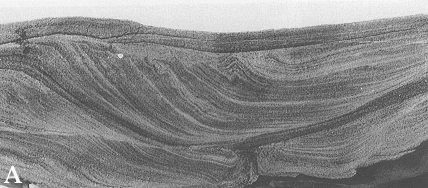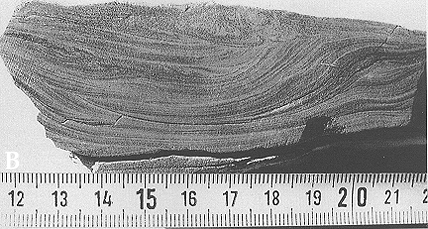

Current drag effects on foreset laminae
Plate 119


Current drag effects on foreset laminae
Plate 119
Some of the deformations illustrated in the previous plate are here shown in more detail. They occur in thin, cross-laminated turbidite beds, i.e., in traction-plus-fallout deposits. Laminae are emphasized by compositional and textural differences, the darker ones being rich in clay and organic (vegetal) matter (see also color photo 7). The grain size is in the coarse silt to fine sand range. Porosity and permeability are relatively low; some plasticity and cohesion is conferred to the sediment by finer and carbonaceous particles.
The paleocurrent (with opposite direction in the two specimens) first formed migrating ripples and cross-laminae, then deformed them in two ways: 1) by oversteepening the foresets, which remained anchored at the base but were dragged at the top; 2) by producing microfolding, or small-scale convolutions. Some microfolds were induced by gravity failure along the foreset slope (A). All such deformation occurred before the youngest laminae were deposited, as the upper picture demonstrates.
It is conceivable that, under the pressure of the current, selective liquefaction occurred: some sand laminae more prone to liquefaction, comprised between less permeable laminae, could yield to pressure and flow.
Marnoso-arenacea Formation, northern Apennines.